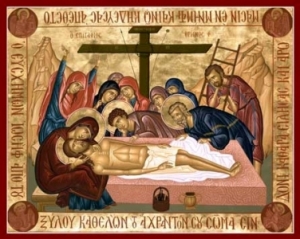
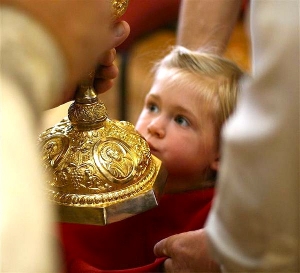
Father George Bithos' weblog

Troparion:
Prophet and Forerunner of the coming of Christ, we honour you lovingly but cannot extol you worthily; for by your birth your mother’s barrenness and your father’s dumbness were unloosed; and the Incarnation of the Son of God is proclaimed to the world.
This week, our Holy Church commemorates the Nativity of the Friend of the Bridegroom
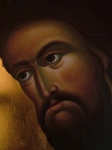
(see book by S. Bulgakov). St. John the Forerunner, a cousin of Jesus, but what is more important, he was, as Jesus himself said, “…among those born of women there has risen no one greater that John the Baptist” (Matt. 11, 11). There is the portrait of John the Baptist, which is presented in the Gospels. We learn that St. John was the answer to a prayer. His parents, Zachariah and Elizabeth were advanced in years. They prayed for a child. Like Sarah, the wife of Abraham, Elizabeth was beyond the time of bearing children. But, God had a plan of salvation and John the Baptist was to be His messenger (Is. 40, 3). God intervened so that His plan could be accomplished. Elizabeth and Zachariah became the parents of a child, who they were instructed to name John. In the first chapter of Luke, we read John was chosen to be the one to prepare the people of Israel for the Lord (Luke 1, 16). What was his message of preparation? This preparation was contained in one word, Repent! If we look at this word closely, John was not asking for sad eyed sorrow for what had been done. He was calling for change, a radical change of direction. Basic to John’s message were the admonitions to stop, think, examine and change. Change the way you live, the way you treat others, the attitudes in your heart and make a new beginning. This new beginning was and is preparation for the KINGDOM OF GOD. This kingdom will arrive with the Incarnation of Our Lord. God with Us, Emmanuel; this is the decisive moment in the history of the world and in our life. John was born to deliver a message, to bear witness to Christ, to be His friend and to disappear(John 3, 30). Do we still hear his message today?
]]>
Representatives of the Local Orthodox Churches were called to meet by his All Holiness Ecumenical Patriarch Bartholomew. They met the 6th – 12th June 2009 at the Orthodox Centre of the Ecumenical Patriarchate in Chambésy, Geneva, Switzerland to discuss one topic, the Orthodox Churches of the Diaspora. We are the Diaspora. The definition of what the “Diaspora” can be found below (see the underlined text) in the portions of the communiqué that was issued at the conference. The reason that this whole process has started is because our Church structure is, quite frankly, uncanonical. Why you ask? Well, the canons of the Church state: that there is One Orthodox Bishop in a city for all Orthodox in that geographical area. Here in the States, for example, you can have a Greek Orthodox bishop, an Antiochian Orthodox bishop, an OCA bishop, a Serbian bishop and more in the same city. THIS IS NOT THE WAY THE SYSTEM WAS DESIGNED. Our history is quite complex and the reality is that the Orthodox in America, Western Europe and Australia are organised ethnically. This is not an acceptable situation. His All Holiness and the other Church leaders realise this and are starting to begin a process that will remedy this situation. The representatives met under the president-ship of Metropolitan John of Pergamon,

who was appointed by the Patriarch. This is part of their statement.
“The Conference expressed the willingness of Orthodox Churches to solve the problem of the canonical organisation of the Orthodox Diaspora, conforming to ecclesiology, tradition and canonical practice of the Orthodox Church. The Conference decided to create new episcopal assemblies in some regions of the world to order the question of the Diaspora, i.e. the Orthodox faithful installed in areas beyond The traditional boundaries of the local Orthodox Churches. The presidents of the Assemblies are bishops of the Ecumenical Patriarchate in the given region, and in their absence, the bishops in accordance with the order of the Diptichs of the Churches. All the bishops of the Orthodox Churches who exercise their pastoral ministry in the communities existing in each of these regions are members of these Assemblies. The Episcopal Assemblies are for the mission to manifest and promote the unity of the Orthodox Church, to exercise pastoral diakonia to the faithful of the region and to render to the world their common witness. The decisions of the Episcopal Assemblies are taken in accordance with the principle of unanimity of the Churches represented within these Assemblies by bishops.
…The remaining topics of the holy and great Council, i.e. the method of proclaiming of autocephaly and autonomy, and the order of Diptichs, will be discussed in future meetings of the preparatory inter-orthodox commission and will be submitted for approval to the following Pre-conciliar Pan-Orthodox Conferences.”
These representative will meet again, in the mean time we PRAY!
]]> 
Last Sunday, we commemorated the Holy Fathers of the First Ecumenical Council who met in Niceae in the early fourth century (325 AD). When I got home I started to think about why we haven’t had an ecumenical council since the eighth century. Historically, we should review some facts about all the councils. All these gatherings had some common denominators.

OK, what is the hold up, it’s been since 787AD. Haven’t we had burning issues in the Church since the eighth century? What about the Great Schism? Didn’t this issue warrant a great conclave to settle the dispute? It seems to me (just personal speculation) that two related reasons may have disturbed the accustomed polity of the Church. One was the person and influence of the imperial house. Namely, the emperor who, following the example of St. Constantine, always convened the councils. What happened after the eighth century was Islam. The Byzantine Empire was confronted by the peril of Islam and the Church’s regular relationships between all the five ancient patriarchates was disturbed. Later, the emperor was literally fighting for the life of the empire. We all know about the estrangement of the western church through political issues and ego. Then came the crusades and the relationships between the East and West deteriorated. There were several attempted councils of “reunion”; but they were, quite frankly, coerced in the face of the eminent fall of Constantinople and the Islamic threats. The works of St. Mark Eugenics detail the difficulties for the Orthodox at Council of Ferrara-Florence in the mid 15th century. Then came the times of captivity, both the Ottoman and the Communist eras.
Now times have changed, but one thing that has not changed is the great need for the Church to come together and discuss things that need attention. I, for one applaud, His All Holiness for moving in the direction of calling a great council of the Church. Let’s not be so cynical by immediately thinking of “evil agendas” and “egos”. This week as we prepare for Pentecost, don’t we, as Orthodox Christians, still believe that the Holy Spirit lives in the Church? The council will convene and the Spirit will assure the outcome, not the machinations of politics and human desires. What should you and I do to guarantee the outcome? PRAY, start from now and fervently pray for the council. Then and only then can we as the faithful influence the conclave.
]]> 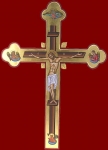 The True Cross
The True Cross
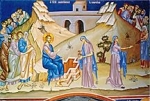
This week our Church commemorates the Sunday of the Paralytic. The Gospel reading is taken from St. John 5, 1 – 15. One thing struck me after I read this passage. Aren’t all of us paralyzed in one way or the other? The young man in the Gospel account was physically impaired for many years, but he never gave up on the possibility of being healed. He waited by the pool for thirty-eight years for his deliverance.
Many of us who are paralyzed spiritually, emotionally or psychologically sit by the side of life. There may be limitations to our understanding, we may not be able to move past a scar on our heart, perhaps we cannot forgive some hurt we have experienced. Do we live our life trying to be healed or trying to ignore our malady? The question that Christ asked the young man is very pertinent to our own circumstances or powerlessness, “Do you want to be healed?” At first, the obvious response would be an indignant, “of course,” but many of us wear our debilitation as a badge of identity. Not too many weeks ago, we were anointed with the sacrament Holy Unction. While we were being anointed, the invocation reminded us that Christ is the physician of our souls and bodies. Souls and bodies, we are told that the young man needed physical healing. Nonetheless, waiting next to the pool for thirty-eight years to be healed must have left emotional scars on the young man. As we analyze all the miracles of Christ, He heals each person whom He encounters; provided that the person turns him in faith. The healing always restores the person to wholeness. So, it is understood that all aspects of this paralyzed man was healed.
Turning to Christ in faith is not a magic formula. Wholeness involves the restoration of our spirit. This restoration may impart to us the capacity to recognize our paralysis, to understand its cause and to start on a path to wellness. Its possible physical limitations remain with us to illumine our heart to overcome the deeper emotional weakness. The healing of Christ is a mystery as is the opportunity to witness His love in our life. Our witness, like the young man’s in the temple, is the acknowledgement that God is working to transform our heart.
]]>


PASCHA 2009
